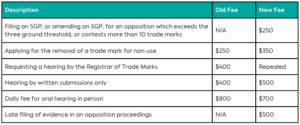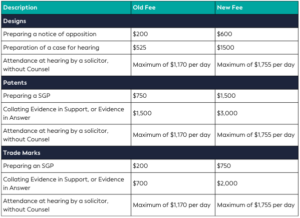Being Assertive Comes at a Price – IP Australia Fee Hike
IP Australia have finalised their 15-month fee review process and announced changes to their official fees for designs, patents, plant breeders’ rights and trade marks. Design, plant breeders’ rights and trade mark filing fees remain largely similar, however, there have been significant changes to trade mark and patent fees in contentious proceedings. To counterbalance these increases, IP Australia have outlined that successful parties in contentious proceedings are also eligible to recover more costs under the new regime. IP asset holders across Australia should all be readily aware of the key changes as they come into effect today.
A comprehensive summary of all fee changes can be found here.
Trade Mark Fee Changes
The goods news for future and current trade mark holders is that IP Australia have not increased filing and renewal fees.
However, new fees have been introduced for pursuing extensive trade mark oppositions. The basic fee for the notice of Opposition has doubled and is now $500. However, if you wish to:
- attack a third-party trade mark application on more than 3 grounds of opposition, each additional ground will now cost $250. Therefore, the cost of a Notice of Opposition could now range from $500 to $2,750 (if all grounds of opposition under the Trade Marks Act 1995 (Cth) (Act) are pursued); and
- rely on more than 10 prior marks in an attempt to establish substantial identity/deceptive similarity under section 44 of the Act, an extra $250 fee will be imposed for each of the eleventh and further trade marks claimed. In practice, however, it is rare for opponents to rely on more than 10 prior marks. Therefore, this fee increase is largely theoretical.
A new $500 fee will now be payable for the late filing of evidence. Again, this fee is largely theoretical because, after the ‘Raising the Bar‘ legislation (the Intellectual Property Laws Amendment (Raising the Bar) Act 2012 (Cth)) came into force on 15 April 2013, it is nearly impossible to obtain an extension of time to file evidence in trade mark opposition proceedings.
A summary of the key fee changes for trade marks is detailed below:

Patent Fee Changes
There has been a marginal increase to patent filing and examination fees.
However, significant fee changes have been applied to contentious patent proceedings, with fees having doubled for filing oppositions and requesting, or appearing at, a hearing.
Moreover, patent applications with more than 20 claims will now also incur a fee at the first examination report stage. If the twenty claim threshold is eclipsed after the first examination stage, a fee will be applied at the acceptance stage of the application. The fees themselves haven’t increased, the changes simply enable the fees to now be payable during the examination stage of an application.
A summary of the key fee changes for patents is detailed below:

Recoverable Costs
IP Australia have announced that greater costs will be recoverable by successful parties in design, patent and trade mark proceedings, with the maximum recoverable amount for some items having more than doubled. These changes have been summarised in the table below:

Key Takeaways
IP asset holders should be aware of the increased fees for expansive trade mark and patent claims/oppositions prior to filing any supporting documents which commence these processes. However, they can take some comfort in IP Australia having made some increases to the maximum costs recoverable for successful parties in design, patent and trade mark proceedings. Notably, however, these increases are still completely at odds with the actual costs incurred by the parties in these types of proceedings.
Co-author(s): Nicholas Zambounis, Law Graduate